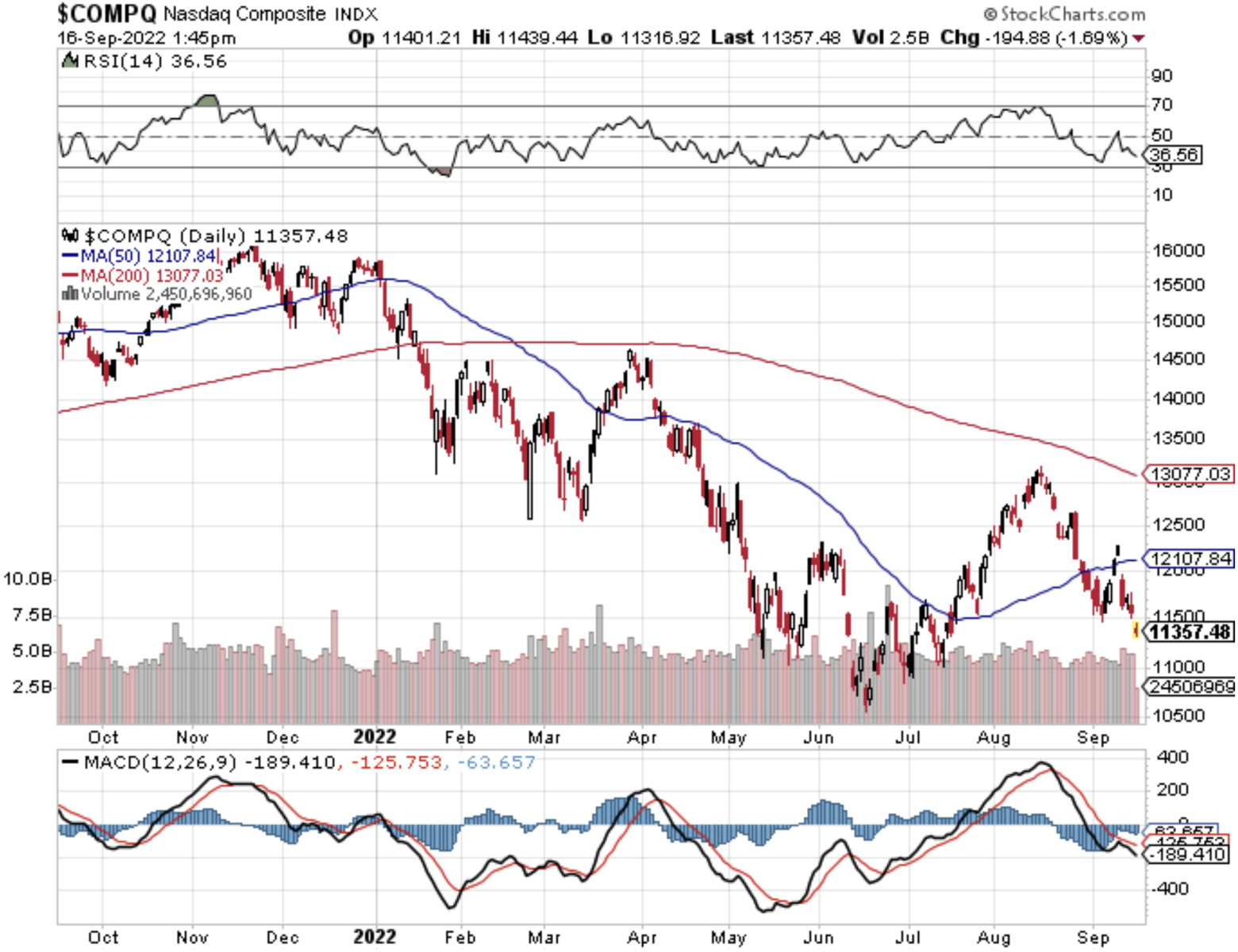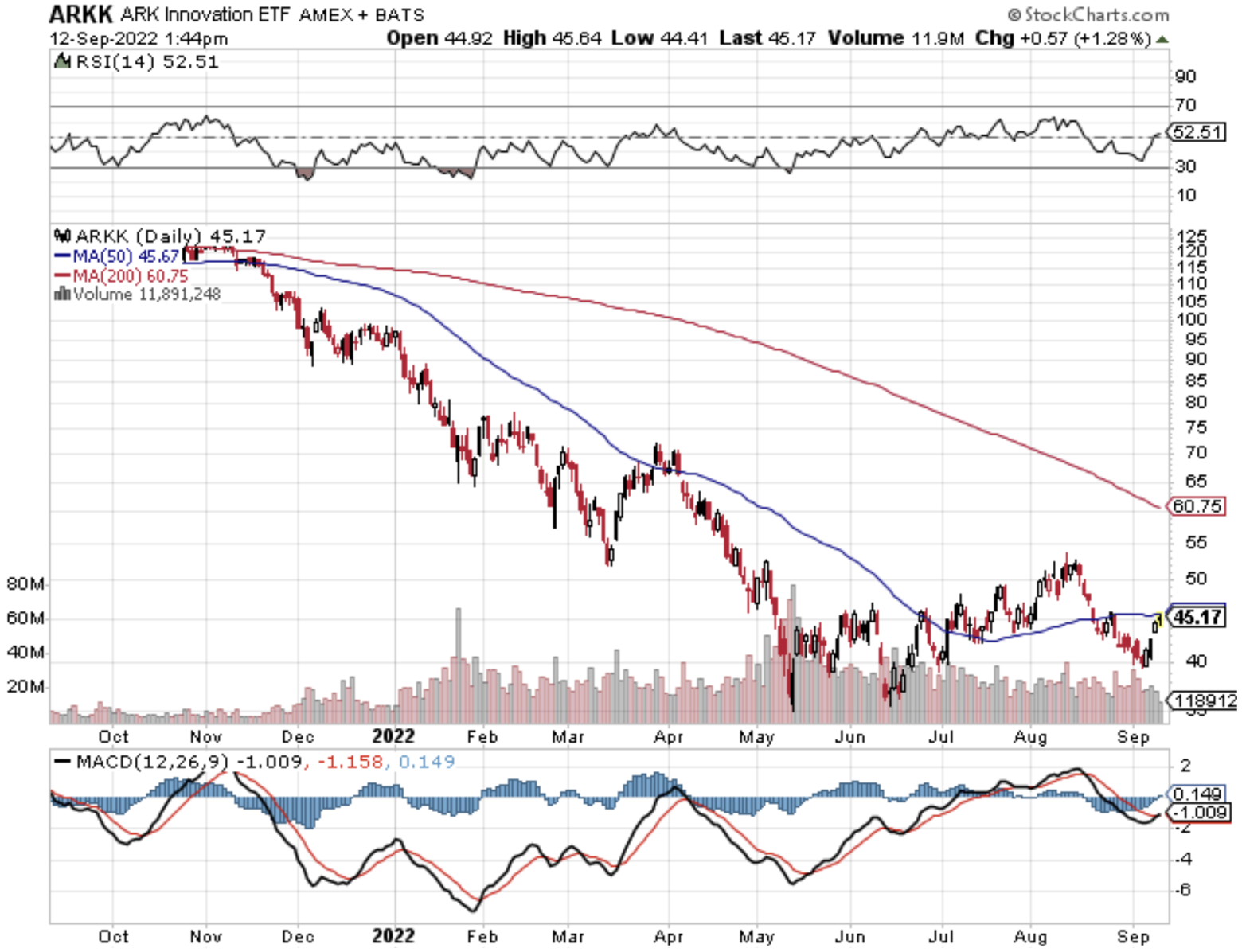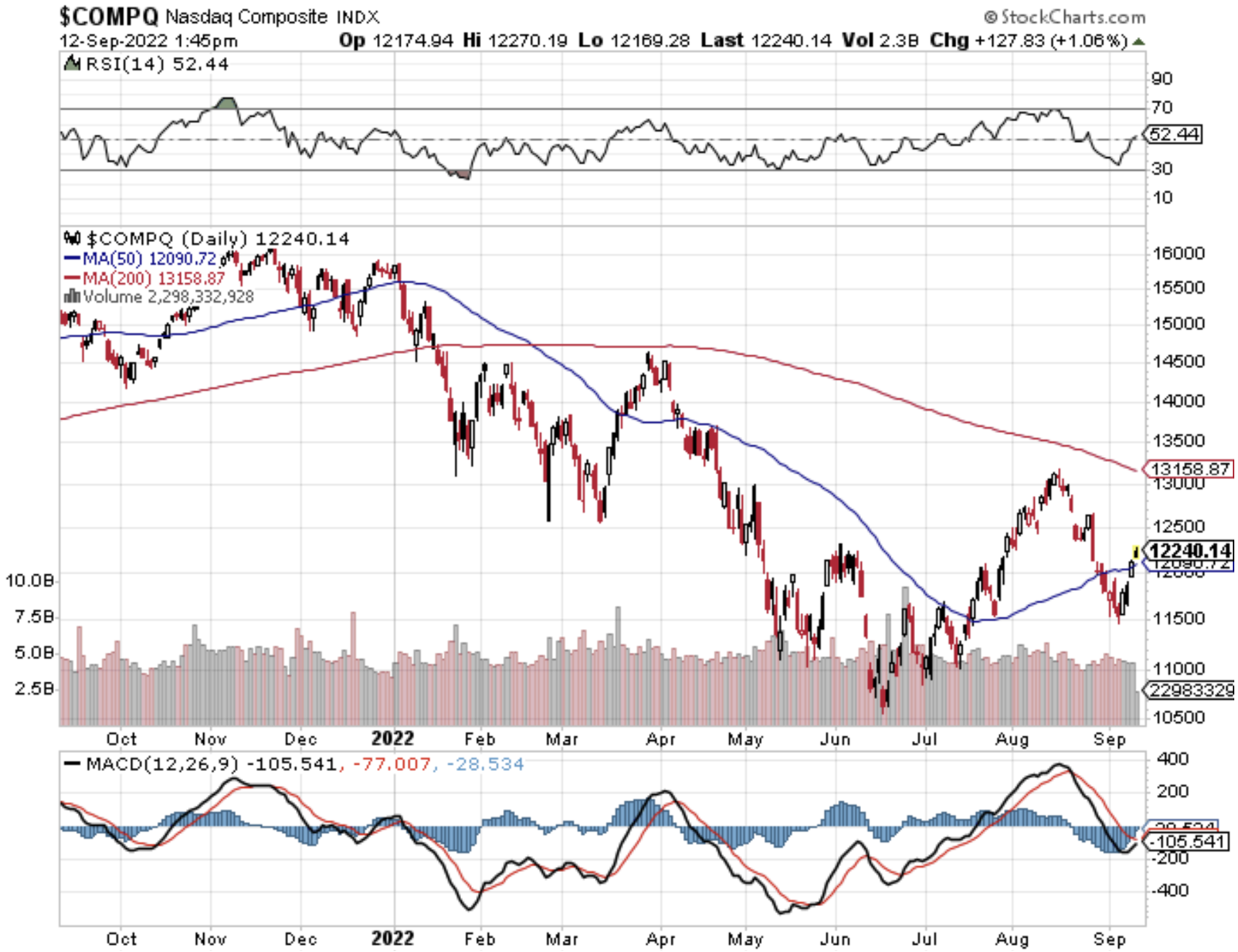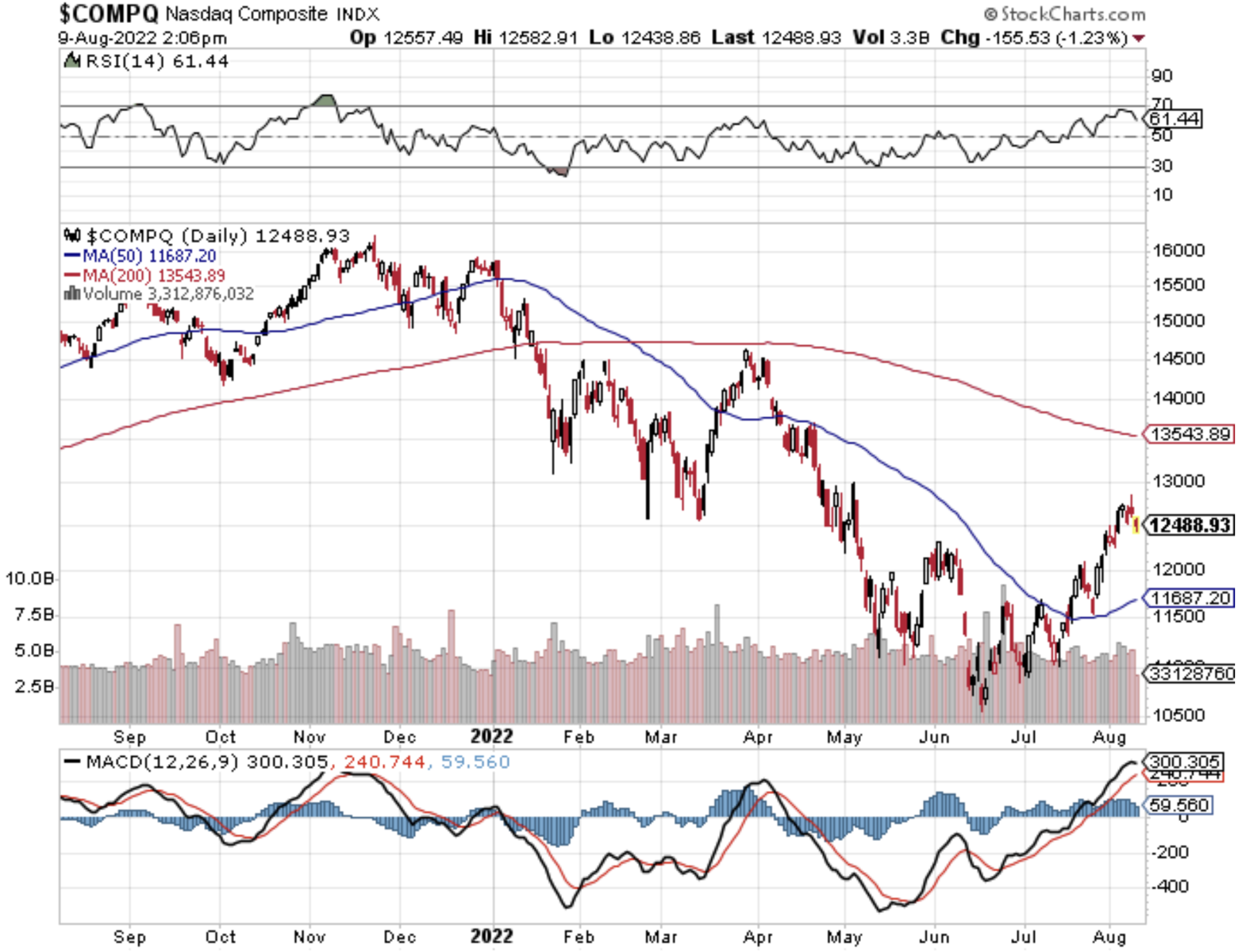Mad Hedge Technology Letter
September 16, 2022
Fiat Lux
Featured Trade:
(THE NEW RULES TO TECH STOCKS)
(TINA), ($COMPQ)

Mad Hedge Technology Letter
September 16, 2022
Fiat Lux
Featured Trade:
(THE NEW RULES TO TECH STOCKS)
(TINA), ($COMPQ)

First, I would like to welcome the hundreds of new subscribers that just recently decided to take the plunge by hand selecting the Mad Hedge Technology Letter.
Our services have experienced a record-breaking year as novice investors and seasoned pros seek out the best tech stock ($COMPQ) advice in turbulent markets which have been riddled with high volatility.
There has never been a better time on earth to be human and there has never been a better time to subscribe to this technology content, offering cheat codes to the technology sector.
On the surface, it doesn’t seem that way.
Daily headlines don’t offer a positive spin on the world with energy caps, social unrest, military operations, supply shortages, cost of living crises, and extreme weather delivering us humble pie in many alternative forms.
However, readers must get in tune with the new world of tech investing.
The most essential thing to know is that passive investing is dead in this new world of high-interest rates, a rapidly deleveraging asset bubble, and broken supply chains.
Passive investing is tailor-made for a low volatility, high liquidity and a low-interest rate environment which has been swept into the dustbin of history.
This world basically ended in March 2020.
If readers aren’t actively managing their tech stocks, then you are behind the game as there are new laws to the land in the wild west of tech stocks.
As managers' focus on active management continues to accelerate, investors are becoming more inclined to not only enlist the service of active managers, but to reward them with even greater responsibility, access, and attractive opportunities.
A survey of 125 advisors found that 66% of respondents are more inclined to consider an active manager now than before.
Active advisors are also more likely to be considered in 2022 than passive managers with 89% of respondents saying they are unhappy with their passive ETF performance in 2022.
Almost all show a loss.
The evidence is there for everyone to see.
Investors are migrating away from passive index funds that cannot make money when a basket of stocks go down.
This strategy only works during times of synchronized global growth.
Investors also liked how passive investing was cheap because managers did not have to take profits before an imminent collapse.
Now they do, and I must admit it does create higher execution costs, but would you want to be outright long as streaming services are losing subscribers in an accelerated fashion and constantly giving us downgrades and lower revenue targets?
The truth is that there are a lot of bad active managers out there with a poor track record.
Many don’t know how to time the market, hedge risk, and don’t understand how to analyze or prioritize the large swaths of data that inundate us every day.
The Mad Hedge Fund Trader solves this for you.
Similar to the dynamics of Silicon Valley, risk asset performance is also a winner takes all industry. Tech is even more volatile relative to the S&P meaning even more diligence is required to outperform the Nasdaq.
The shift from passive to active is a paradigm shift that many still haven’t been alerted to.
To top it off, many conservative investors I have chatted to have now been cut off from their go-to industry – real estate.
Readers also won’t be able to effectively invest in real estate with 6% mortgage interest rates and generational high prices with owners sitting on a mountain of equity, boasting 3% mortgages, and nowhere to move if they sell.
For lack of better words, there is no alternative or TINA – which is why there has been an avalanche of interest in how to actively navigate tech stocks.
It’s no surprise that a large portion of our new subscribers come from real estate backgrounds and are looking for new opportunities.
Go where your money is treated best, and I can tell you that you’ve found the right place.
Quit being passive and act fast!


Mad Hedge Technology Letter
September 12, 2022
Fiat Lux
Featured Trade:
(CATHIE WOOD URGES ACTION)
(ARKK), ($COMPQ)

CEO of Ark Invest and infamous creator of the ARK Innovation ETF (ARKK) Cathie Wood defiantly said that “innovation solves problems, and the world is facing many more problems today than two years ago. Innovation is key to real growth!”
She likes to keep on banging on about innovation being the panacea to the tech industry when the big tech titans are doing absolutely zilch regarding innovation.
Offering new personalized lock screen designs doesn’t move the needle, but that doesn’t mean that tech stocks ($COMPQ) will go down and shareholders will lose money.
Quite the opposite for the tech cash cow business models.
She later goes on to complain that “The Fed seems to be responding to COVID-related supply shocks spanning 15 months the same way that Volcker battled inflation that had been brewing and building for 15 years. I would not be surprised to see a significant policy pivot in the next three to six months.”
First, Fed Central Bank governor Jerome Powell is nowhere close to the Volker era which saw short-term U.S. interest rates raised to 20% in 1981.
Powell is the antithesis of former Fed chair Paul Volcker and that’s why these bear market rallies are strong and lasting.
Powell wants a “soft landing” – that’s his goal.
The Fed has continuously said they aren’t ready to pivot and by pivot, I mean going from raising rates to lowering rates.
Wood believes that raising rates does nothing to help supply side shocks and that the Fed should start to condition itself to soon lower rates.
The Fed deals solely participates in demand-side policies.
The Fed is on record saying they plan to raise Fed Funds rates to 4% by the end of 2023 and keep rates there for an extended period.
That timeline seems to clash with Wood’s idea of dropping rates in 3 months.
The reason Wood has little credibility is because she has been saying the economy is experiencing deflation every 2 weeks for the past 3 years.
She has the most to lose because her portfolio possesses speculative tech stocks that mostly execute unprofitable business models and need low rates to refinance their large debts just to survive.
She continued to say that the Fed should be looking at metrics like “gold and copper” which “are flagging the risk of deflation.”
It’s quite bizarre that gold would be selected as the leading indicator for monetary policy.
Last time I checked, people can’t eat or drink gold and gold doesn’t heat your shower or apartment, even if you can install golden toilets like Russian President Vladimir Putin. Consumers can’t drive gold either. Higher or lower gold prices don’t indicate that our discretionary budgets are crashing or bulging either.
She also says to completely ignore employment because it’s a “lagging indicator.” This last sentence is false as well as it seems she is confusing this with the unemployment rate being a lagging indicator.
Unfortunately for Wood, the Fed slowly raising rates means it will be longer until they lower them because rates are still highly accommodative.
The silver lining for Wood is that the Fed is more worried about breaking the stock market which could evaporate trillions of dollars in stock market wealth.
Bear market rallies are essential for a soft landing, and we are seeing them in full force.
The last thing investors need is a crashing stock market and impotent tech companies. Remember that Silicon Valley and the tech industry are still the drivers of the US economy.
The Fed will do what they need to do to engineer the result of a soft landing regardless of Cathie Wood.


Mad Hedge Technology Letter
August 31, 2022
Fiat Lux
Featured Trade:
(BACK TO THE OFFICE)
(COMPQ)

The writing is on the wall for in-person office attendance – it’s never coming back, and why should it?
Sure, the fathers with 3 young children love to go to the office to get away from the noise, but mostly everybody else likes to work from home.
That will not change.
Recent data points back to my thesis and show that the dispersion of young tech workers throughout the United States will alter the make-up of the tech industry.
First, it will make tech wage bills demonstrably lower since most companies have a policy of paying per local wage structure.
If workers move from Manhattan, New York to Boise, Idaho, tech workers will get paid a Boise wage.
The latest thwarted recall by New York state has fallen on deaf ears.
For instance, New York Mayor Eric Adams called on city residents to “get back to work” after the arbitrary lockdowns.
His call to action was met with a resounding thud and Adams recently acknowledged hybrid work may be here to stay.
Nearly one-quarter of workers are in the office twice a week, according to the survey, with that number dipping to 11% for four days a week.
Still, the share of employees who are working fully remote fell from 54% in October 2021 to 28% in late April, the survey said.
While the numbers show more workers are heading back to the office than a few months ago, the survey also unveiled that remote work is likely to persist, as 88% of employers have said a hybrid office model has a high chance of permanent existence.
Naturally, the percentage of fully remote workers was due to dip because the country opened back up, we simply aren’t locked up anymore.
However, I believe we will migrate into a binary world where high-production workers will be able to spell out the type of work environment they want, and low-production workers won’t have any negotiating power to dictate terms.
At the very worst, highly productive workers will be forced into in-person office work 1-2 times per week if they are alpha workers.
This shows the amount of leverage that tech companies have lost in their battle to retrench workers back into the old world that no longer exists.
The world has really changed since early 2020 and the tech industry is still fumbling through the fallout and unintended consequences.
Geographically, this is a disaster for tech strongholds like Silicon Valley and good for the low tax strongholds of Austin, Texas, and Florida.
On the bright side, this phenomenon will produce new, exciting, and successful tech companies from parts of the world we never heard of.
Lastly, for the thriving entrepreneur, these events mean that it has never been cheaper to create and maintain a tech company with no need to pay for office space and the ability to outsource work to an army of remote workers in different time zones.
The elevated job vacant numbers reveal that tech workers are being pickier in what job they want to do and increasingly choosy in what type of politics they hope their employer to have.
Outperformance has never been so important in 2022 and the treatment of top employees compared to low-level employees has never been starker and more polarized.
Essentially, I am highly bullish on the future of technology and it’s up to us to create this thriving environment.

WHO NEEDS THE OFFICE?
Mad Hedge Technology Letter
August 12, 2022
Fiat Lux
Featured Trade:
(WAITING FOR LIFT-OFF)
(AMZN), ($COMPQ)

The broader stock market will be saved, and the Nasdaq, comprised of tech firms, will be able to muddle through this bubble-deleveraging cycle completely unscathed.
To this day, the only meaningful erosion has appeared in the crypto industry and Chinese property developer market, which isn’t even in the U.S.
With the likes of Amazon staging a roaring rally, the situation is in good shape heading into 2023.
I would categorize relative performance as an unequivocal victory as the tech market sniffs out a rate cut cycle.
The interest rate cut cycle is forecasted to start in June 2023, giving us just 10 months to get to the point where tech explodes upwards.
I can guarantee that quality tech stocks will be higher than they are 2 years from now.
So let me throw some cold water on all those fear mongers.
This “rude awakening” that certain armchair experts are warning us about is yet to surface in Corporate America.
Despite the erosion of wage gains by high inflation, Corporate America has yet to show a substantial uptick in bankruptcies.
In a report published earlier this month, S&P counted only 212 U.S. bankruptcy filings from the start of the year through July 31.
This marked the fewest number of bankruptcy filings through the first seven months of any year going back to at least 2010.
Credit investors do not appear to be concerned about widespread defaults in the future either.
A recent survey from Bank of America Global Research showed a nudge higher in credit investor expectations for the rate of corporate defaults over the next year. But at 3.1%, the expected corporate default rate is far lower than expectations during the health situation.
The naive analyst would say these are remarkable statistics considering how financial conditions have tightened amid the Federal Reserve's aggressive rate hikes aimed at tamping down inflation, which have resulted in a doubling of longer-term interest rates. This resulting rise in rates increases the burden for companies carrying high levels of debt.
But let me bring you back to reality. A 2.5% Fed Funds during 9.1% inflation means that capital conditions are HIGHLY accommodative.
Even Facebook did their first debt offering in these conditions with a $10 billion bond.
The numbers still make financial sense to borrow at 2.5% in a 9.1% inflationary environment because the 5.5% in real interest gains is an asset to hold onto.
In fact, the 5.3% inflation in 2021 means that a 2-year aggregate relative gain of 11.9% against inflation means that borrowing over the past 2 years has been a no-brainer.
Acceleration in borrowing costs should be acknowledged — and unfortunately, profit margins come down and we don’t get as rich.
Cry me a river.
But the aggregate statistics show corporate tech companies are not only super strong but also one of the major benefactors of the global enterprise over the past 3 years as we have lurched from crisis to crisis.
The truth is that many investors are sitting on a mountain of equity via pocketed stimulus checks, dividends, PPP loans, and other gargantuan subsidies.
Ultimately, the crown jewels of tech are in position to skyrocket once these central bankers push through miniscule interest rate hikes over the next 10 months.
The last thing these professional bureaucrats want to do is rock the boat.
Therefore, they are doing just enough to show they care about inflation without really tackling it, so for the next rate lowering cycle, risk assets will go bananas from a much higher cost base.
Position yourself right, get the timing correct, and the path to riches is in reach.


Mad Hedge Technology Letter
August 10, 2022
Fiat Lux
Featured Trade:
(THE VISION FUND NEEDS MORE VISION)
(SOFTBANK), ($COMPQ)

Last quarter, the tech ($COMPQ) bellwether venture fund Softbank lost $23 billion!
The Founder Masayoshi Son is a genius at losing money.
For those doing the math, that’s over $10 million PER HOUR in Q2 or $3000 per second.
His poor decisions cost the likes of Saudi Arabia, The UAE, and other cashflow-rich entities.
The Saudi oil money got sold on the dream of “reimagining salad delivery” and building coupon apps for dogs.
It didn’t work.
It's fair to say there was a gross misallocation of funds buoyed by an era of cheap capital, and now many of these business models have blown up.
Over-capitalization of startups has a way of masking fundamental business models.
Even Uber. The unit economics make zero sense as a ride-share with higher gas prices, expensive car insurance, higher gross wages, and expensive debt issuances.
They have never justified their valuation and they are still in business only because they are a monopoly.
It’s crazy to think a company like this is still worth an overinflated $61 billion today because it should be closer to $15 billion.
CEO Masayoshi Son's multibillion-dollar investment spree over the past few years has shredded his fat ego as rising interest rates and recession fears decimated tech shares and venture capital investments.
Warren Buffet likes to say when the tide comes in, we get to see who’s swimming naked.
Son added that he will be making big changes over the coming months, looking to be “more selective in making investments,” because “the market and the world are in confusion.”
Vision Funds have backed over 470 startups globally in the past six years, but SoftBank approved just $600 million in investments for the funds in the April-June quarter, a 97% decline in spending from the same quarter last year.
Son is also firing a bloated staff which clearly, he doesn’t need since performance and stock prices have gone out the window.
SoftBank was also forced to sell $10.5 billion of the Chinese e-commerce giant Alibaba’s stock to raise cash in the April-June quarter and dumped an additional $6.8 billion in shares after the quarter ended.
SoftBank saw its losses from stock market investments pile up during the April-June quarter. The Vision Fund alone saw $2.18 billion in losses from its stake in the South Korean e-commerce leader Coupang, which is down 33% year to date, and $1.64 billion in losses from DoorDash, which has dropped 46% since January.
But it’s the Vision Funds' early-stage investments that are seeing the worst results amid an ongoing venture capital slowdown, with startups such as the buy-now, pay-later darling Klarna losing billions in value so far this year.
Startups don’t thrive in this current high inflation, high interest rate, supply chain bottleneck economy.
Stagflation fears have skyrocketed.
Son is finding out the hard way with these young companies decimated and is grasping at straws.
In this world, tech investors must filter the strong amongst the pitiful and the broad-brush approach of buying a massive basket of emerging tech won’t work anymore if a good chunk of them are fat zeroes.
The massive tech bubble is still deflating as the Fed is pedal to the metal with raising interest rates.

Legal Disclaimer
There is a very high degree of risk involved in trading. Past results are not indicative of future returns. MadHedgeFundTrader.com and all individuals affiliated with this site assume no responsibilities for your trading and investment results. The indicators, strategies, columns, articles and all other features are for educational purposes only and should not be construed as investment advice. Information for futures trading observations are obtained from sources believed to be reliable, but we do not warrant its completeness or accuracy, or warrant any results from the use of the information. Your use of the trading observations is entirely at your own risk and it is your sole responsibility to evaluate the accuracy, completeness and usefulness of the information. You must assess the risk of any trade with your broker and make your own independent decisions regarding any securities mentioned herein. Affiliates of MadHedgeFundTrader.com may have a position or effect transactions in the securities described herein (or options thereon) and/or otherwise employ trading strategies that may be consistent or inconsistent with the provided strategies.
This site uses cookies. By continuing to browse the site, you are agreeing to our use of cookies.
OKLearn moreWe may request cookies to be set on your device. We use cookies to let us know when you visit our websites, how you interact with us, to enrich your user experience, and to customize your relationship with our website.
Click on the different category headings to find out more. You can also change some of your preferences. Note that blocking some types of cookies may impact your experience on our websites and the services we are able to offer.
These cookies are strictly necessary to provide you with services available through our website and to use some of its features.
Because these cookies are strictly necessary to deliver the website, refuseing them will have impact how our site functions. You always can block or delete cookies by changing your browser settings and force blocking all cookies on this website. But this will always prompt you to accept/refuse cookies when revisiting our site.
We fully respect if you want to refuse cookies but to avoid asking you again and again kindly allow us to store a cookie for that. You are free to opt out any time or opt in for other cookies to get a better experience. If you refuse cookies we will remove all set cookies in our domain.
We provide you with a list of stored cookies on your computer in our domain so you can check what we stored. Due to security reasons we are not able to show or modify cookies from other domains. You can check these in your browser security settings.
These cookies collect information that is used either in aggregate form to help us understand how our website is being used or how effective our marketing campaigns are, or to help us customize our website and application for you in order to enhance your experience.
If you do not want that we track your visist to our site you can disable tracking in your browser here:
We also use different external services like Google Webfonts, Google Maps, and external Video providers. Since these providers may collect personal data like your IP address we allow you to block them here. Please be aware that this might heavily reduce the functionality and appearance of our site. Changes will take effect once you reload the page.
Google Webfont Settings:
Google Map Settings:
Vimeo and Youtube video embeds:
